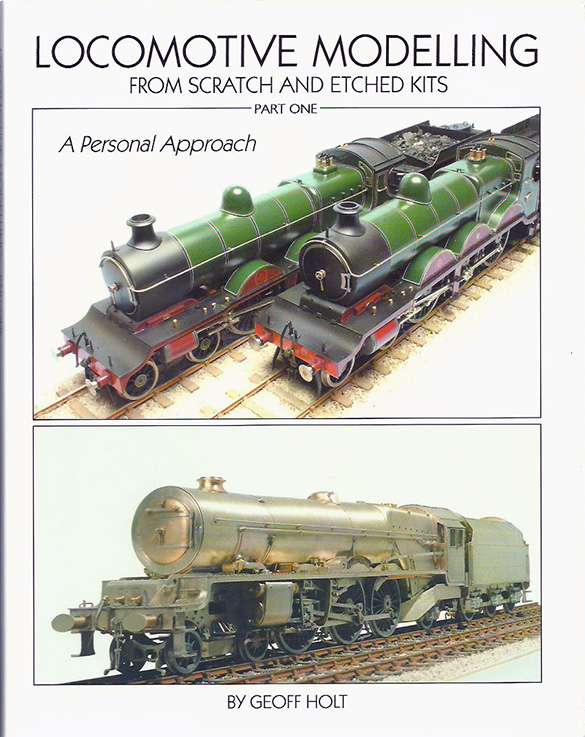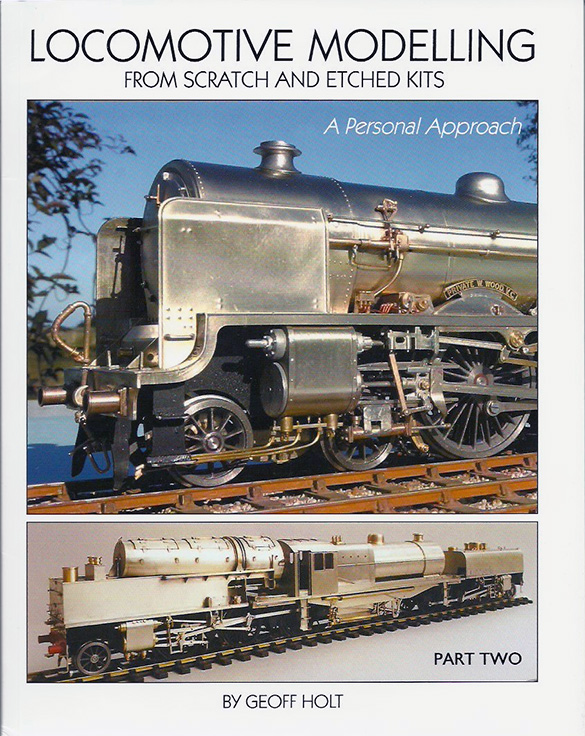Locomotive Modelling: From Scratch and Etched Kits, A Personal Approach
Parts One and Two by Geoff Holt.
ISBN 978-1-908763-01-3 (Part One)
ISBN 978-1-908763-05-1 (Part Two)
(See the link at the end of this review for pricing information.)
Wild Swan Publications Ltd.
1-3 Hagbourne Road, Didcot, Oxon, OX11 8DP
Locomotive Modelling: Part One
At the end of World War II, during a stint in a Royal Air Force maintenance unit, Geoff Holt made a chance acquaintance with a German POW who had a fascination with railways and whose prisoner duties included the disposal of surplus war material. The two made an arrangement whereby useful surplus items would be set aside for Geoff to use in a scratchbuilt model of the Stephenson’s Rocket, thus starting him on a life-long journey of scratchbuilding where he would become recognized as a master of his chosen craft. He graciously shares a sampling of that knowledge with the rest of us through these two volumes of his work.
Part One
Following a short introduction and author background, Chapter One discusses the motivation and inspiration needed to see a long project through and ways to organize the work and research such an involved project will require. He also considers how one might choose which locomotive to build and the kit options available in the UK, which are quite different from what we’re used to in the US.
Chapter Two outlines the basic and advanced tooling required to produce good results in kits and scratchbuilt models, while Chapters Three and Four consider the material choices and how to work with them. The cutting, bending, rolling and forming of brass sheet stock is well covered, as is making rivets and soft soldering.
Chapter Five looks at the critical skills involved in reading official drawings, along with the use of photographs and how to translate said material from one scale into another. There is also a look at making working drawings for your build and the development of plastic patterns for use with pantographs, a drawing tool that allows one to trace a drawing made to one scale and simultaneously make a drawing at a different scale.
Chapters Six and Seven get down to the heart of any locomotive project: laying out and building an accurate frame for a smooth running mechanism (chapter six) and the joys of dealing with the rods and valve gear in its many iterations (chapter seven). Book one concludes here.
Part Two.
Locomotive Modelling, Part Two continues the story by starting with Chapter Eight, making the two volumes a true companion set. In Part Two, Chapter Eight covers the fabrication of the running plates, valances and splashers, or the running boards in US terms. Here is one of many areas where British design differed greatly from American practice.
Chapter Nine covers boiler construction, both straight and tapered, along with techniques for making Belpaire fireboxes. While most British locomotives did not feature the stepped boiler configuration of many American designs, this chapter should still serve you well.
Chapters Ten and Eleven discuss the cab and its features like windows, gangway doors, gangway and fall plates along with roofs and interior details. Chapter Eleven covers the rest of the sundry details like washout plugs, handrails, buffers, couplings, lamp holders and appliances such as injectors and lubricators.
The tender and its construction are well documented in Chapter Twelve and Chapter Thirteen covers the requirements of electrical pickup, decoder installation and test running. Chapter Fourteen looks at the process of initial running and shake-down testing and related matters, while Chapter Fifteen looks at preparing a model for painting and reassembly. Lastly, Chapter Sixteen is a welcome introduction to metal working with a lathe. Finally, as a bonus, there are four pages of reproduced handwritten letters from one of Geoffs’ many friends in the Appendix, along with a list of suppliers (UK of course) on the inside back cover.
The text for each chapter is beautifully supported by large format, full color photography that is well lit and composed. In addition, there are drawings to illustrate processes that are difficult to photograph. While comprehensive and in-depth, the text is not cumbersome to follow. Indeed, it reads well and held my attention without drowning me in minutia. I now have several titles from Wild Swan and their production values in each are excellent. The books are as satisfying to the eye and hand as they are with regard to the topics covered.
Will these books answer every question? No, of course not. No one book or series could hope to do that. Taken together, though, these two volumes present 239 plus pages of insights into the mind of a skilled craftsman. These texts are now all the more invaluable given Mr. Holt’s passing on April 19, 2013 at the age of 85.
Both volumes are available from Wild Swan and, perhaps more simply for those in the United States, they are available from International Hobbies in Auburn, California. You may order them by phone or via the web from International. Check their website for current pricing and availability. I have no affiliation with nor receive anything from Wild Swan Publications Ltd. or International Hobbies beyond being a satisfied customer and fan.
I enthusiastically recommend these volumes to your attention.
Regards,
Michael Cougill


0 Comments